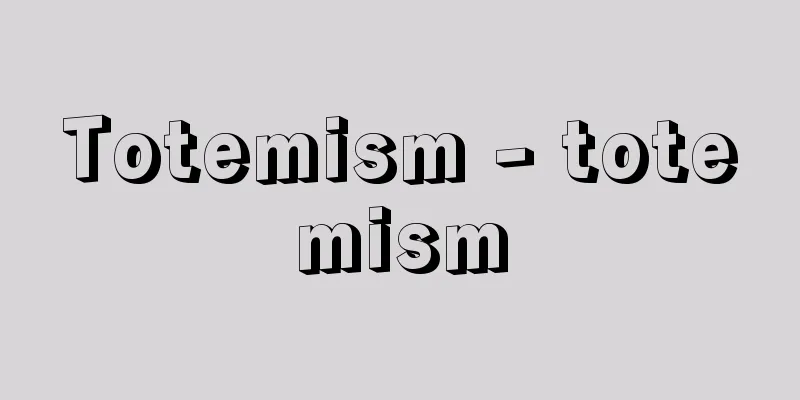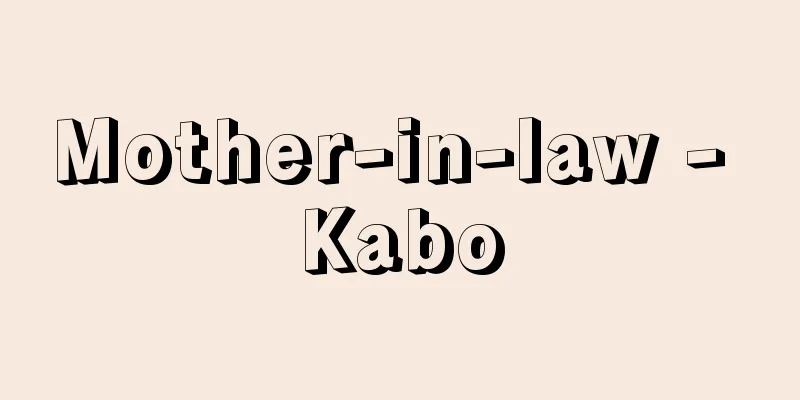Totemism - totemism

|
It refers to the belief in totems and the system based on them, and is derived from the word ototeman (he is of my tribe) of the Native American Ojibwa. It first attracted attention as a belief and system seen among American Indians, but later it was reported that similar things were seen in Australia, Africa, Melanesia, Polynesia, India, etc., and the concept and meaning of totemism has been much discussed mainly in religious studies, sociology, anthropology, and psychology. However, even if it is reported under the term totemism, its actual substance varies greatly depending on the region and society. At the same time, the concept and definition of totemism varies depending on the researcher, making it difficult to generalize, but based on the view of British anthropologist Radcliffe Brown, it is usually defined as follows, with the caveat that there are many different examples: Totemism is the belief and system that a certain human group has a special relationship with a specific species of animal, plant, or other thing, and that specific species is called a totem. [Itabashi Masami] form(1) Most totems are animals or plants. However, there are various types. For example, the Australian aboriginal Aranda have more than 400 different animal and plant species as totems, while the African ethnic groups Nyoro and Bahima have only cows as totems, and each clan has a specific type of cow (red cow, dairy cow, etc.) or a part of the cow's body (tongue, intestine, heart, etc.) as its totem. There are types in which each clan has one totem and types in which each clan has multiple totems, and in Melanesia, each clan often has one bird, one tree, one mammal, and one fish as its totem. In addition to animals and plants, natural objects and natural phenomena such as the sun, moon, clouds, snow, rain, fire, water, and seasons are also totems in Australia. There are many places, including India, where artificially created objects are used as totems. For example, the totems of the Bhils of India are 19 plants, 17 animals, and 7 objects (a short sword, a broken bottle, a village, a spiked stick, a bracelet, an ankle ring, and a piece of bread). Other examples of totems in northeastern Australia include sleep, diarrhea, vomiting, sexual intercourse, and various mental states. (2) Totems are associated with groups such as clans, half-tribes, and hordes. In addition, in southeastern Australia, there are gender-based totems, with men being associated with bats and women with woodpeckers. Among Northwestern American Indians, individuals may have specific totems. However, some believe that personal totems are simply guardian spirits. (3) A group is called by the name of its totem. For example, the Ojibwa have five main clans named after the crane, the loon, the bear, the marten, and the catfish. However, groups are often called by names other than their totems. For example, on the Polynesian island of Tikopia, four clans have special connections with the taro, yam, breadfruit, and coconut palms, but are not called by those names. (4) In group totemism, people with the same totem do not marry, meaning that the totem group is the exogamy unit. This is because totem affiliation is usually based on the principle of descent. However, there are many exceptions to this. For example, in the society of the Aranda, the indigenous people of Australia, the principles of marriage regulation and totem affiliation are separate. Marriage regulation is based on the principles of descent and generation, but totem affiliation is linked to the place where the mother became pregnant (pregnancy is believed to be the entry of an ancestor spirit from a totemic sacred place into a woman's body). (5) They have myths that tell the origin of the connection between a totem and a human group. The totem is said to be the ancestor of the group, or that the totem and the group have a common ancestor, or that the ancestor of the group had a close relationship with the totem. The Wild Mustard Clan of the Native North American Hopi has the names Oak, Roadrunner, and Warrior, because in a legendary migration they encountered a crying child, gave him mustard leaves and oak branches to calm him down, and then encountered the Roadrunner and Warrior. The Badger and Butterfly Clan got their names because their ancestor brought a badger man they had met, and immediately afterwards caught a butterfly for the child's entertainment. However, there are many cases where they do not have such myths or legends. (6) The strong bond between a totem and a group is expressed through beliefs, rituals, and emotional and mystical means. For example, it is said that a totem animal is friendly to members of the group that bears the totem's name and does not attack them, or that humans resemble the totem animal in appearance and personality. In the society of the Native American Chippewa, it is said that members of the fish clan are long-lived and have thin or thin hair, members of the bear clan have long, black, and thick hair, and are angry and combative in temperament, and members of the crane clan are loud and eloquent. Taboos against killing, collecting, or eating one's own totem are widespread. In northern Australia, it is forbidden to eat not only one's own totem, but also the totems of one's father, mother, and grandfather. Sometimes it is forbidden to see, touch, or even speak the name of the totem. The Oraon people of India, whose totem is iron, are not allowed to touch iron with their lips or tongue. However, there are many cases where these taboos are not observed. In the Ojibwe, a Native American people of North America, it is said that the totem animal is the one that is shot by the hunters of the clan named after the totem. Totem groups reenact myths that tell the relationship between the totem and the group through rituals, and regularly hold worship ceremonies for the totem. In Australia, it is common to go to the sacred place of one's totem and hold such a kind of propagation ceremony. (7) People may have signs, designs, or carvings that represent their totem. The totem poles of North American Indians are one example. In Australia, there are things called thuringas, which are roughly oval shapes made of stone or wood with symbolic symbols carved into them. [Itabashi Masami] theorySince its introduction at the end of the 18th century, totemism has been a topic that has attracted the interest of many researchers. It is a cultural and social phenomenon that shows extremely diverse and complex aspects, and various theories have been put forward about not only the concept of totemism but also its meaning. Research on totemism differs depending on which aspect is emphasized, and can be broadly divided into those that view it as a form of magic or religion, and those that focus on its social aspects. McLennan, a pioneer in totemism research, considered it to be a religion derived from animal worship, while Mallet and the British scholar Frazer viewed it as magic. In either case, early research on totemism took a cultural evolutionist standpoint and dealt with the issue of the origin of religion, considering totemism to be primitive and an expression of a primitive mentality. The French philosopher Durkheim taught that totemism is a belief in an impersonal power (mana) symbolized by a material object called a totem, and is a religion. At the same time, he emphasized its social origin, and taught that the totem is a social symbol, a "flag," and plays a role in social cohesion. The view that focuses on the social aspects of totemism began with Goldenweiser, but was passed on to Durkheim and then to Radcliffe Brown. He basically followed Durkheim's theory, stating that the totem is a symbol of group unity, and that people confirm the solidarity and continuity of the group through the rituals surrounding this belief. However, regarding the reason why certain animals and plants are chosen as totems, he rejected Durkheim's theory that totems are given ritual importance because they are chosen to represent the group, and instead argued that totems are chosen because they are important for other reasons. In other words, he suggested that the things chosen as totems have economic and other values and play an important role in society. Lévi-Strauss, who critically inherited these studies, regards totemism as one of the expressions of the human spirit that is universal to all human beings, whether primitive or civilized. According to him, the things chosen as totems are "suitable for eating," that is, not because they have economic value, but because they are "suitable for thinking." The logic of totemism is to express the relationship between groups through the relationship between other things, and it finds homologies and parallel relationships between the classification, differences, and conflicts of groups in society and those between animals and plants in nature, and expresses the former through the latter. For example, if clans A and B have hawks and crows as their totems, respectively, the relationship between clans A and B is the same as the relationship between hawks and crows, specifically, the relationship between A and B, which is hostile on the one hand and united through marriage on the other hand, is analogized to the relationship between hawks eating raw meat and crows eating carrion, but the same in that they are both birds that eat meat. The psychologist Freud's interpretation of totemism is also well-known. He related totemism the prohibition of incest, and said that the sons killed their father (the primal father) who had absolute power and monopolized women, but regretted it and created a system called totemism to prohibit marriage within the totemic group. [Itabashi Masami] "The Savage Mind" by Levi-Strauss, translated by Yasuo Ohashi (1976, Misuzu Shobo) [Reference] |Source: Shogakukan Encyclopedia Nipponica About Encyclopedia Nipponica Information | Legend |
|
トーテムに対する信仰、およびそれに基づく制度をいい、北アメリカの先住民オジブワのototeman(彼は私の一族のものだ)という語に由来する。初めはアメリカ・インディアンの間にみられる信仰、制度として注目を集めたが、その後、オーストラリア、アフリカ、メラネシア、ポリネシア、インドなどにも類似のものがみられることが報告され、それとともにトーテミズムの概念、その意味について、主として宗教学、社会学、人類学、心理学の間で多くの議論がなされてきた。しかし、トーテミズムという語で報告されていても、その実体は地域によって、社会によって非常に異なる。同時に、研究者によってトーテミズムの概念、定義はさまざまであり、一般論は困難であるが、イギリスの人類学者ラドクリフ・ブラウンの見解に基づいて、多くの異なる例があるという但(ただ)し書つきで、普通次のように定義される。すなわち、トーテミズムとは、ある人間集団が特定の種の動植物あるいは他の事物と特殊な関係をもっているとする信仰、制度であり、その特定種をトーテムという。 [板橋作美] 形態(1)トーテムとなるものは動物や植物が多い。ただしこれには種々の型がある。たとえばオーストラリア先住民のアランダは400種以上の異なる動植物種をトーテムとするが、アフリカの民族集団ニョロやバヒマは牛のみがトーテムとなり、各氏族は牛の特定のタイプ(赤牛、乳牛など)か、牛の体の部分(舌、腸、心臓など)をトーテムとする。また各氏族が一つのトーテムをもつ型と複数のトーテムをもつ型があり、メラネシアではしばしば各氏族が鳥1種、樹木1種、哺乳(ほにゅう)動物1種、魚1種をトーテムにもつ。動植物のほかに、たとえばオーストラリアでは日、月、雲、雪、雨、火、水、季節などの自然物や自然現象もトーテムとなる。インドをはじめとして、人工的につくられた物品がトーテムになる所も少なくない。たとえばインドのビール人がトーテムとするものは植物19、動物17、物品7(短刀、割れ瓶、村落、とげ付き棒、腕輪、足首輪、パン切れ)である。そのほか睡眠、下痢(げり)、嘔吐(おうと)、性交、さまざまな精神状態といったことがトーテムにされる例がオーストラリア北東部などにある。 (2)トーテムは氏族、半族、ホルドなどの集団と結び付く。そのほかオーストラリア南東部には性によるトーテムがあり、男はコウモリを、女はキツツキをトーテムとする。また北西アメリカ・インディアンの間では個人が特定のトーテムをもつこともある。ただし個人トーテムは単に守護霊だとする考えもある。 (3)集団はそのトーテムの名でよばれる。たとえばオジブワにはツル、アビ、クマ、テン、ナマズの名がついた五つの主要氏族がある。しかし集団がトーテムとは別の名でよばれることも少なくない。たとえばポリネシアのティコピア島では、4氏族がそれぞれタロイモ、ヤムイモ、パンノキ、ココヤシと特殊な関係にあるが、それらの名でよばれてはいない。 (4)集団トーテミズムの場合、同じトーテムをもつ者の間では結婚しない、つまりトーテム集団が外婚単位となる。これはトーテム所属がたいてい出自原理に従うからである。しかしこれにも例外は多い。たとえばオーストラリアの先住民アランダの社会では、婚姻規制とトーテム所属の原理は別である。婚姻規制は出自と世代の原理に基づくが、トーテム所属は母親が懐妊した場所(妊娠はトーテム聖地にいる祖霊が女性の体に入ることと考える)に結び付いている。 (5)トーテムと人間集団の結び付きの由来を語る神話をもつ。トーテムはその集団の祖先であるとか、トーテムと集団は共通の祖先をもつなどの親族関係が語られたり、集団の祖先がトーテムと親密な関係をもっていたなどといわれる。北アメリカ先住民のホピの野生カラシの氏族はオーク(樫(かし))、ミチバシリ(ホトトギス科の鳥)、戦士という名をもっているが、それは伝説上の移住の途中で泣いている子供に出会い、カラシの葉とオークの枝を与えて泣きやませ、そのあとでミチバシリ、戦士に出会ったからである。アナグマとチョウの氏族の名のおこりは、先祖が知り合ったアナグマ人間を連れてきて、そのすぐあとで子供の慰みにチョウをつかまえてやったからである。しかしそのような神話、伝説の類をもたない場合も多い。 (6)トーテムと集団との強い結び付きは信仰、儀礼によって、また情緒的、神秘的に示される。たとえば、トーテム動物はその名をもつ集団の者に好意をもっていて襲わないとか、人間の外見や性格がトーテム動物に似ているなどといわれる。北アメリカ先住民のチッペワの社会では、魚の氏族の者は長命で毛髪が細いか薄い、クマ氏族の者は髪が長くて黒くて濃く、また気質が怒りっぽく戦闘的、ツルの氏族は声がけたたましく弁舌家であるといわれる。自分のトーテムは、殺したり、採集したり、食べたりしないという禁忌は広くみられる。オーストラリア北部では自分のトーテムだけでなく、父、母、祖父のトーテムを食べることも禁じられている。ときには見ること、触れること、その名を口にすることすら禁止されている。インドのオラオン人で、鉄をトーテムとする人々は、唇や舌で鉄に触れてはならない。しかし、これらの禁忌を伴わない例もまた多い。北アメリカの先住民オジブワでは、トーテム動物は自分の名の氏族の狩人に好んで撃たれるといわれる。トーテム集団はトーテムと集団の関係を物語る神話を儀礼によって再現したり、定期的にトーテムへの崇拝儀礼を行う。オーストラリアでは自分のトーテムの聖地へ行ってその種の増殖儀礼を行うことがよくみられる。 (7)自分のトーテムを表す標識、図案、彫刻をもつ場合もある。北アメリカのインディアンのトーテムポールはその一つである。オーストラリアにはチューリンガとよばれる石か木でつくったほぼ楕円(だえん)形でその上に象徴的記号を彫り込んだものがある。 [板橋作美] 理論トーテミズムは18世紀末に紹介されて以来多くの研究者の関心を集めてきた問題であるが、きわめて多様で複雑な様相を示す文化的、社会的現象であり、トーテミズムの概念についてはもちろん、その意味についてもさまざまな説がたてられてきた。トーテミズム研究は、どの側面に重点を置くかによって異なり、大きく、呪術(じゅじゅつ)、宗教としてみる立場と、その社会的側面に注目するものとに分けられる。トーテミズム研究の先駆者マクルナンはこれを動物崇拝に由来する宗教とみなし、マレットやイギリスのフレーザーは呪術とみたが、いずれにせよ初期のトーテミズム研究は文化進化主義的な立場にたって、宗教の起源をめぐる問題として取り扱い、トーテミズムは原始的なものであり、原始心性の表れと考えた。フランスのデュルケームは、トーテミズムをトーテムという物質的なものに象徴される非人格的な力(マナ)に対する信仰であり、宗教であると説くと同時に、その社会的起源を強調し、トーテムは社会の象徴、「旗」であり、社会的結合力としての役割を説いた。トーテミズムの社会的側面に注目する見方はゴールデンワイザーに始まるが、デュルケームを経てラドクリフ・ブラウンに受け継がれた。彼は基本的にはデュルケームの説を踏襲し、トーテムは集団の統一の象徴であり、人々はこの信仰をめぐる儀礼を通して集団の連帯性、持続性を確認するという。しかし、トーテムとして特定の動植物が選ばれる理由について、トーテムは集団を代表するものとして選ばれたがゆえに儀礼的に重要視されるというデュルケームの説を退け、逆にトーテムは他の理由で重要だから選ばれたのだとする。すなわち、トーテムに選ばれたものは経済的その他の価値をもち、社会のなかで重要な役割を果たしていると示唆(しさ)する。 これらの諸研究を批判的に継承したレビ(レヴィ)・ストロースは、トーテミズムを、未開と文明を問わず人類に普遍的な人間精神の表れの一つとしてとらえる。彼によれば、トーテムに選ばれたものは「食べるに適している」、つまり経済的に価値があるからではなく、「考えるのに適している」からである。集団間の関係を他の事物の関係によって表現するのがトーテミズムの論理であり、社会における集団の分類、違い、対立といったものと、自然界の動植物間のそれらとの間に相同、平行関係をみいだし、前者を後者によって表すのである。たとえばAとBの氏族がそれぞれタカとカラスをトーテムとするということは、A氏族とB氏族の関係のあり方はタカとカラスの関係のあり方と同じ、具体的にはAとBは一方では敵対し、他方では婚姻を通して連帯する同じ部族であるという関係が、タカは生肉を食べカラスは腐肉を食べる点では対立し、ともに肉を食べる鳥という点では同じであるという関係に類比されるのである。 なお、心理学者フロイトのトーテミズムの解釈も有名である。彼はトーテミズムを近親相姦(そうかん)の禁止と関連づけ、絶対的権力をもち女性を独占していた父(原父)を息子たちが殺害したが、彼らはそれを後悔し、トーテミズムという機構をつくり、トーテム集団内の婚姻を禁止したのだとする。 [板橋作美] 『レヴィ=ストロース著、大橋保夫訳『野生の思考』(1976・みすず書房)』 [参照項目] |出典 小学館 日本大百科全書(ニッポニカ)日本大百科全書(ニッポニカ)について 情報 | 凡例 |
>>: Dodecanese [Islands] - Dodecanese
Recommend
Speech understanding system
A system that processes input speech information a...
Recoverable reserves - Recoverable reserves
The amount that can be economically and technicall...
McKim, Mead and White
The most influential architectural firm in the lat...
cancer
…In ancient Egypt, there was a word that correspo...
Yoshimatsu Goseda
Year of death: September 4, 1915 Year of birth: Ap...
Anaphylactic reaction
…In the past, allergic reactions were broadly div...
Eschatology - eschatology
It is a concept, thought, or doctrine about the &...
remex
…three types of wing feathers can be distinguishe...
Assassin - With all due respect
〘Noun〙 = Shikaku (assassin) ※Shiji Sho (1477) vol....
Kilian, G.
…There have been attempts to systematically under...
Essex (Warship) - Essex
… [During World War II] At the beginning of the P...
Magnesium mineral
Magnesium is a mineral whose main component is Mg....
Fisheries Disaster Compensation System - gyogyousaigaihoshouseido
A mutual aid system aimed at providing relief and...
Heinrich von Ofterdingen
A legendary medieval German poet. The oldest work ...
AGIP
…Like IRI (Industrial Reconstruction Corporation)...









